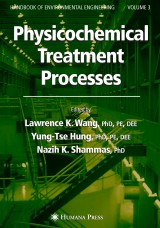Details

Physicochemical Treatment Processes
Volume 3Handbook of Environmental Engineering, Band 3
|
213,99 € |
|
| Verlag: | Humana Press |
| Format: | |
| Veröffentl.: | 13.11.2007 |
| ISBN/EAN: | 9781592598205 |
| Sprache: | englisch |
| Anzahl Seiten: | 724 |
Dieses eBook enthält ein Wasserzeichen.
Beschreibungen
The past 30 years have seen the emergence of a growing desire worldwide to take positive actions to restore and protect the environment from the degrading effects of all forms of pollution: air, noise, solid waste, and water. Because pollution is a direct or indirect consequence of waste, the seemingly idealistic demand for “zero discharge” can be construed as an unrealistic demand for zero waste. However, as long as waste exists, we can only attempt to abate the subsequent pollution by converting it to a less noxious form. Three major questions usually arise when a particular type of pollution has been identified: (1) How serious is the pollution? (2) Is the technology to abate it available? and (3) Do the costs of abatement justify the degree of abatement achieved? The principal intention of the Handbook of Environmental Engineering series is to help readers formulate answers to the last two questions. The traditional approach of applying tried-and-true solutions to specific pollution pr- lems has been a major contributing factor to the success of environmental engineering, and has accounted in large measure for the establishment of a “methodology of pollution c- trol. ” However, realization of the ever-increasing complexity and interrelated nature of current environmental problems makes it imperative that intelligent planning of pollution abatement systems be undertaken.
Screening and Comminution.- Flow Equalization and Neutralization.- Mixing.- Coagulation and Flocculation.- Chemical Precipitation.- Recarbonation and Softening.- Chemical Oxidation.- Halogenation and Disinfection.- Ozonation.- Electrolysis.- Sedimentation.- Dissolved Air Flotation.- Gravity Filtration.- Polymeric Adsorption and Regenerant Distillation.- Granular Activated Carbon Adsorption.- Physicochemical Treatment Processes for Water Reuse.- to Sludge Treatment.
Many human activities-and industrial production in particular-require enormous quantities of clean water and, at the same time, produce enormous quantities of wastes and pollution that require the development of major physical-chemical technologies, processes whose implementation and costs must be justified by the degree of treatment achieved. In Physicochemical Treatment Processes, Volume 3 of the Handbook of Environmental Engineering, a panel of practicing professional engineers and respected educators critically survey both the principles and practices involved in water pollution control, potable water treatment, water reuse, and sludge treatment. The authors discuss the performance, potential, and limitations of each major physicochemical treatment process in detail-including the physical and chemical theory behind it, the applications, the design procedures, examples, references, and cost data-as a basis for intelligent planning and realization of abatement systems. Among the processes covered are screening, comminution, flow equalization, neutralization, mixing, coagulation, flocculation, chemical precipitation, oxidation, recarbonization, softening, halogenation, and disinfection. Additional chapters discuss ozonation, electrolysis, sedimentation, dissolved air flotation, gravity filtration, granular activated carbon adsorption, and sludge treatment. The emphasis throughout is on developing the necessary engineering from fundamental principles of chemistry, physics, and mathematics. Two companion volumes, Air Pollution Control Engineering, Volume 1, and Advanced Air and Noise Pollution Control, Volume 2, survey the basic air pollution control techniques and the use of multiple techniques to deal with air, thermal, and noise pollution.<BR>
Cutting-edge and highly practical, Physicochemical Treatment Processes, Volume 3 offers educators, students, and practicing engineers a strong grounding in the principles of this critical field, as well as effective methods for developing optimal physical-chemical technologies at costs that are fully justified by the degree of treatment achieved.
Cutting-edge and highly practical, Physicochemical Treatment Processes, Volume 3 offers educators, students, and practicing engineers a strong grounding in the principles of this critical field, as well as effective methods for developing optimal physical-chemical technologies at costs that are fully justified by the degree of treatment achieved.
Includes supplementary material: sn.pub/extras
Diese Produkte könnten Sie auch interessieren:

Decision Support Systems for Risk-Based Management of Contaminated Sites

von: Antonio Marcomini, Glenn Walter Suter II, Andrea Critto

96,29 €

Dynamics of Mercury Pollution on Regional and Global Scales

von: Nicola Pirrone, Kathryn R. Mahaffey

149,79 €














